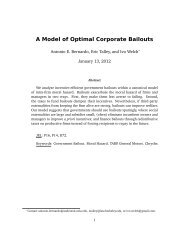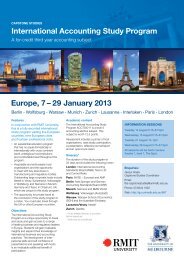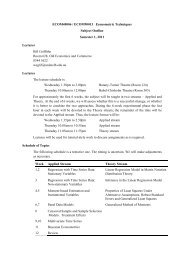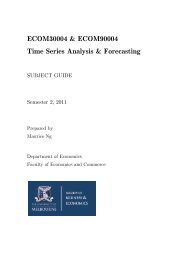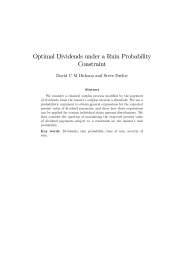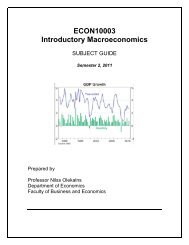The distributions of some quantities for Erlang(2) risk models
The distributions of some quantities for Erlang(2) risk models
The distributions of some quantities for Erlang(2) risk models
You also want an ePaper? Increase the reach of your titles
YUMPU automatically turns print PDFs into web optimized ePapers that Google loves.
From Dickson and Li (2010), the inverse <strong>of</strong> (r 1 + ) 1=2 is a function V 1 (t)given byV 1 (t) = e (+c)t 1X m t m 1 m=2 (ct) (m+1)=2m+12 m!+ 1 2m=0and the inverse <strong>of</strong> (r 2 + ) 1=2 is a function W 1 (t) given byW 1 (t) = e (+c)t21X ( ) m t m 1 m=2 (ct) (m+1)=2m+1m!+ 1 2m=0meaning that the inverse <strong>of</strong> (r 1 + ) 1=2 (r 2 + ) 1=2 is a function, say g(t),given by1Xg(t) = n e (+c)t t 3n+1wheren=0 n = 2n+1 n+1=2 c n+1(2n + 1)! (n + 2) :Hence the inverse <strong>of</strong> (4.5) is the convolution <strong>of</strong> g with a function h, wherefrom (4.4)1Xh(t) = h m e (+c)t t 3m+1wherem=0h m = 2m+1 m+3=2 c m+1:(2m + 2)! m!<strong>The</strong> Laplace trans<strong>for</strong>m (with parameter s) <strong>of</strong> the product <strong>of</strong> the m-th term <strong>of</strong>h(t) and the n-th term <strong>of</strong> g(t) isgivingwhere l =h m n(3m + 2) (3n + 2)( + c + s) 3(m+n)+4h g(t) =1Xl=0 le (+c)t t 3l+3(3l + 4)lXh m l m (3m + 2) (3 (l m) + 2)m=0lX= l+2 2l+2 c l+2 (3m + 1)! (3(l m) + 1)!(2m + 2)! m! (2(l m) + 1)!(l m + 1)!m=010



